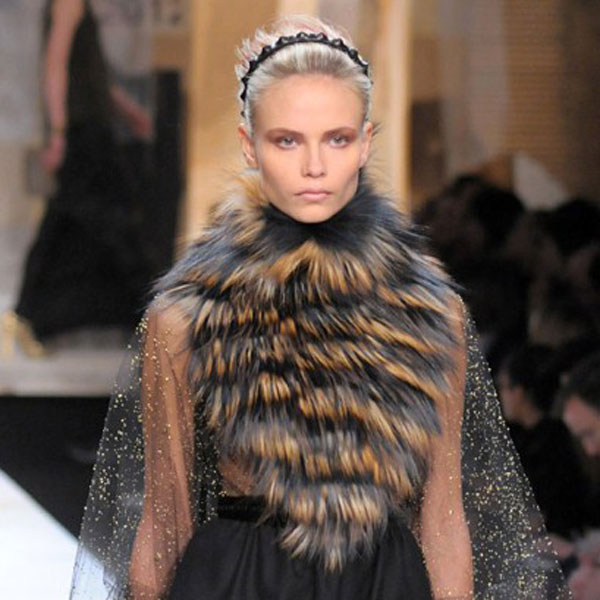While the textile industry as a whole has been recognised as an environmental hazard, fur in fashion remains controversial because of the animal cruelty factor. But with everyday fabrics like cotton heavily depleting and polluting fresh water supplies worldwide, could it be that we need to revaluate our views on fur?
Fur on the up
The fur industry seems to be booming, especially in very cold places such as China and Russia. According to a recent investigation by VICE magazines’ Jenni Avins, auction prices for farmed fur recently reached record highs. On the catwalk fur couldn’t be trendier, and is especially popular in young designer’s collections. Many celebrities are unashamedly showing off their minks and fluffy cuffs, with big designer brands like Giorgio Armani and Gucci happy to supply.
Justified decadence
How did something that used to be a social no-no suddenly become acceptable? Perhaps the demand amongst the high-end, luxury crowd has never really gone away. And because fur represents decadence and power, it could be serving as an extravagant pick-me-up for the middle class during this time of economic downfall.
But could we be missing something? According to an article in The Observer, for the last few years powerful international fur suppliers have been attempting to influence the fashion industry by offering free, top-quality fur to new designers on the scene, in the hope that they will be featured on the catwalk and thus earn publicity. If this is the case, it seems to be working.
While fur farming is banned in places like Austria and the United Kingdom, President Obama of the U.S. recently signed the Truth in Fur Labelling Act – a law which requires all products containing any amount of animal fur to be labelled by species and country of origin. It is clear consumers are becoming more informed, but with much of the focus on the environment, animal cruelty seems to have become low on the agenda.
How fur could be eco
Perhaps the most well-known organisation making these claims is the Fur Council of Canada, with a whole website dedicated to explaining how fur is a potential renewable and sustainable resource – but they are by far not the only ones taking up the green baton on this topic.
The longevity of fur is cited as a reason why it should be considered an eco textile solution, with some furs lasting up to 30 years and then biodegrading. Although it can be argued that fake or faux fur is not an ecologically sound alternative because it is made from petroleum, processing authentic fur could too have a negative effect on the environment due to the use of toxic chemicals like chromium and formaldehyde.
It has even been pointed out by conservationists that the fur industry could help maintain wildlife, using the logic that those businesses who see to benefit from the environment will therefore better take care of it. This is echoed on the International Fur Trade Federation website, which states they harvest only from abundant populations as they have ’a direct interest in protecting habitat and maintaining wildlife populations.’
An interesting angle on ethical fur is in cases where population management of rodents is deemed necessary to protect wildlife – for example clothes made from the pelts of hunted Nutrias (swamp rat) who were destroying the wetlands in Louisiana. While wild fur is not favoured in the industry because it is less smooth than the farmed kind, due to current demands the use of cheaper ‘free-range’ fur has increased significantly.
But it is only in cases where the animals are caught and killed with sustainability in mind and then treated with natural products (like table salt, water and lanolin) that the fur can realistically be deemed green. Wearing second-hand and vintage fur items is also considered eco-friendly, because it is making use of a resource that would otherwise be wasted.
The animal cruelty factor
While animal rights activists’ flour-bomb celebrities like Kim Kardashian for wearing fur, some see these views as too radical and even outdated. Although PETA’s (People for the Ethical Treatment of Animals) long-running campaign ‘I’d rather go naked than wear fur’ gained much publicity in the past, many of the celebrities involved have since donned fur.
Still, it is no secret that most fur farms practise brutal methods on animals that includes beating, electrocution and even skinning them alive. On the one hand we have designers like Stella McCartney who continue to promote ethical fashion, and on the other hand we have Karl Lagerfeld who only has this to say: “In a meat-eating world, wearing leather for shoes and clothes and even handbags, the discussion of fur is childish.”
It is true that depending on whether you are vegetarian are not, this will influence your view on the fur debate. And while fur remains an emotive topic, leather has long been considered okay because it is a ‘by-product’ of the meat industry. The wide-spread practise of animal testing is also something that needs to be taken into evaluation here.
The debate continues
With fur currently popular in the fashion industry, perhaps the eco argument is simply a weak defence. After all, their priority remains fashion, not the ethics of the resources they use. Also it must be noted that trends change rapidly in this industry, meaning fur garments have the potential to be wasteful.
Even though some companies go to great lengths to harvest and process fur in the most environmentally-friendly way possible, this certainly cannot be said for all fur on the market. So if you are choosing to wear fur, make sure you do your homework.
Interesting links:
The Fur Council of Canada (‘fur is green’)
Vice article: journalist hunts down and skins her own fur
The environmental impact of mink fur
Righteous Fur – ‘Save our wetlands, Wear more nutria’
An organisation that fights the international fur trade











